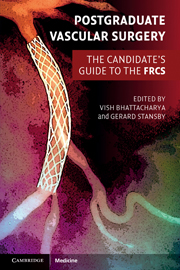Book contents
- Frontmatter
- Contents
- List of contributors
- Preface
- Section 1 Final FRCS vascular clinicals
- Section 2 Final FRCS vascular topics
- 1 Vascular risk factors and their management
- 2 Management of acute limb ischaemia
- 3 Chronic lower limb ischaemia, critical ischaemia and the diabetic foot
- 4 Endovascular and surgical options for peripheral revascularisation
- 5 Abdominal aortic aneurysms
- 6 Thoracic, thoracoabdominal and suprarenal aortic aneurysms
- 7 Aortic dissection
- 8 Popliteal artery aneurysms
- 9 Femoral artery aneurysms
- 10 Carotid, subclavian and vertebral disease
- 11 Diagnosis and management of thoracic outlet syndrome
- 12 Diagnosis and management of hyperhidrosis
- 13 Chronic mesenteric ischaemia
- 14 Acute ischaemic colitis
- 15 Vascular trauma
- 16 Indications and management of lower limb amputation
- 17 Leg swelling and lymphoedema
- 18 Varicose veins and chronic venous insufficiency
- 19 Management of deep vein thrombosis
- 20 Infection in vascular surgery
- 21 Vascular malformations
- 22 Vasospastic disorders and vasculitis
- 23 Critical care considerations and preoperative assessment for general and vascular surgery
- 24 Access surgery
- 25 Basic outline of solid organ transplantation
- Index
- References
10 - Carotid, subclavian and vertebral disease
- Frontmatter
- Contents
- List of contributors
- Preface
- Section 1 Final FRCS vascular clinicals
- Section 2 Final FRCS vascular topics
- 1 Vascular risk factors and their management
- 2 Management of acute limb ischaemia
- 3 Chronic lower limb ischaemia, critical ischaemia and the diabetic foot
- 4 Endovascular and surgical options for peripheral revascularisation
- 5 Abdominal aortic aneurysms
- 6 Thoracic, thoracoabdominal and suprarenal aortic aneurysms
- 7 Aortic dissection
- 8 Popliteal artery aneurysms
- 9 Femoral artery aneurysms
- 10 Carotid, subclavian and vertebral disease
- 11 Diagnosis and management of thoracic outlet syndrome
- 12 Diagnosis and management of hyperhidrosis
- 13 Chronic mesenteric ischaemia
- 14 Acute ischaemic colitis
- 15 Vascular trauma
- 16 Indications and management of lower limb amputation
- 17 Leg swelling and lymphoedema
- 18 Varicose veins and chronic venous insufficiency
- 19 Management of deep vein thrombosis
- 20 Infection in vascular surgery
- 21 Vascular malformations
- 22 Vasospastic disorders and vasculitis
- 23 Critical care considerations and preoperative assessment for general and vascular surgery
- 24 Access surgery
- 25 Basic outline of solid organ transplantation
- Index
- References
Summary
Key points
The extracranial arteries are prone to involvement with a number of important atherosclerotic and non-atherosclerotic conditions
The provision of best medical therapy should not be delegated to the most junior member of the team. It is an essential component of care
Patients with symptomatic carotid disease benefit from very rapid intervention. Investigative strategies and rapid access to the operating theatre should be geared to ensuring all patients are treated within 2 weeks of suffering their index symptom
Relatively few patients with asymptomatic carotid disease benefit from intervention (especially females and patients aged >75 years). It is essential that trials identify high-risk subgroups
The role of several technical aspects of carotid surgery has been guided by large randomised trials
Patients with symptomatic vertebral stenoses may have a much worse prognosis than was previously thought
Radiation arteritis
Demographics
Despite the widespread use of radiotherapy in the treatment of head and neck cancers, there is still insufficient data regarding the incidence of symptomatic radiation arteritis.
Pathology
Acute phase: fibrin deposition/endothelial swelling followed by intimal necrosis.
Subacute phase: endothelial regeneration with destruction of the internal elastic lamina. Inflammatory cell infiltration of the media and adventitia.
Chronic phase: intima becomes thickened with a tendency towards accelerated atherosclerosis. The media and adventitia become progressively fibrotic.
Clinical features
False aneurysm or vessel rupture (acute/subacute phase), stroke due to carotid/vertebral thrombosis, or upper limb ischaemia following subclavian thrombosis (sub-acute phase).
- Type
- Chapter
- Information
- Postgraduate Vascular SurgeryThe Candidate's Guide to the FRCS, pp. 129 - 145Publisher: Cambridge University PressPrint publication year: 2011



